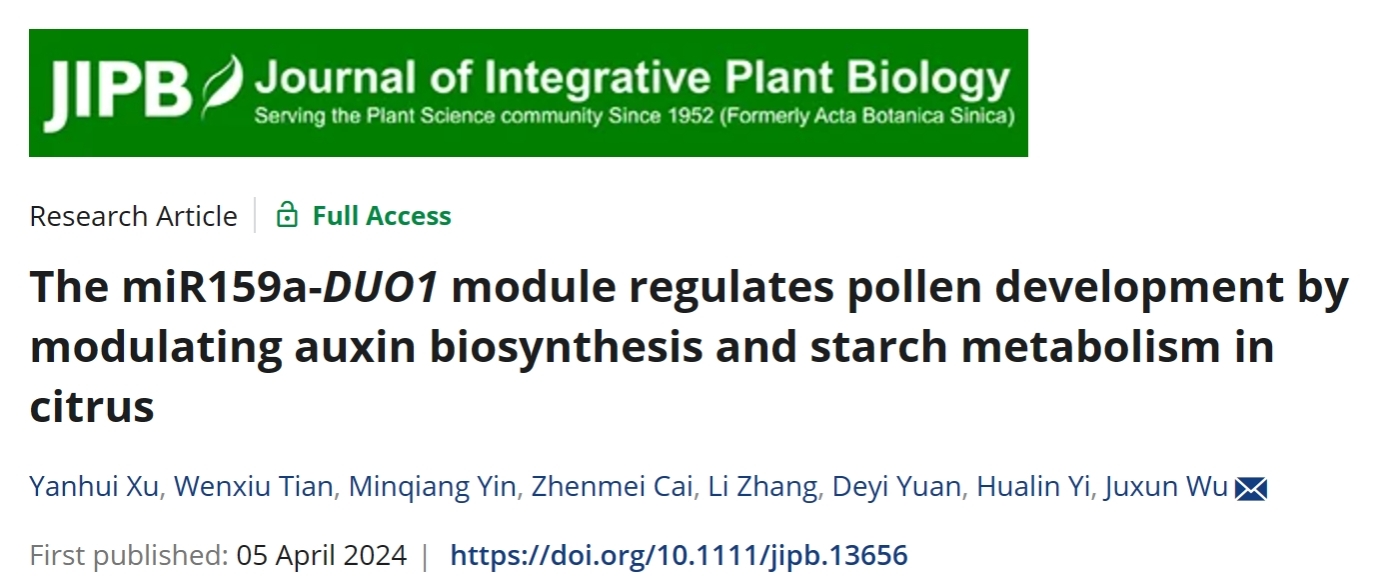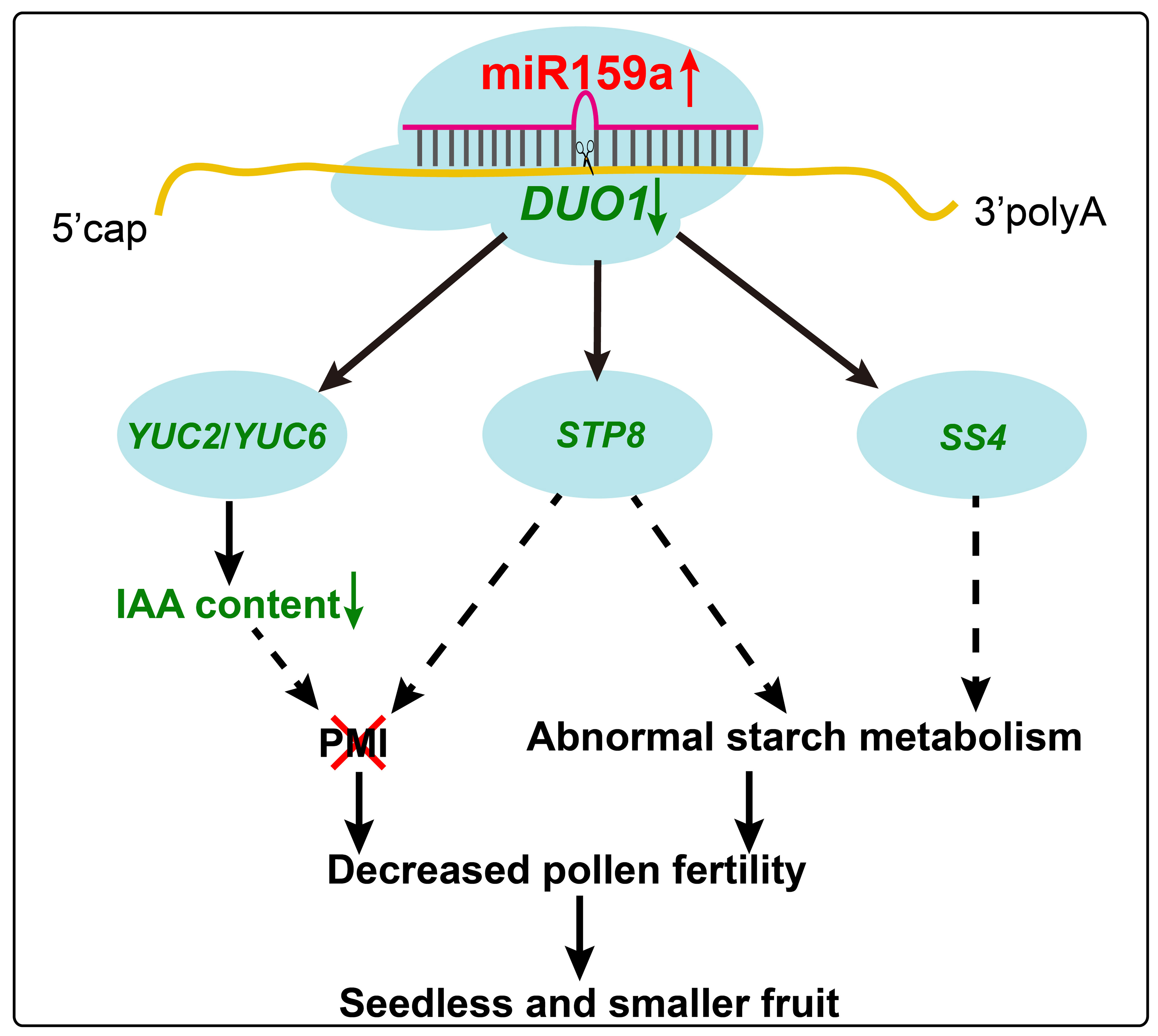南湖新闻网讯(通讯员 徐彦辉)近日,JIPB在线发表了华中农业大学果蔬园艺作物种质创新与利用全国重点实验室伊华林/吴巨勋课题组题为"The miR159a-DUO1 module regulates pollen development by modulating auxin biosynthesis and starch metabolism in citrus"的研究论文,揭示了miR159a-DUO1模块整合生长素合成和淀粉代谢途径调控柑橘花粉发育的分子机制。

果实无核化是柑橘育种的重要目标,是鲜食柑橘品种的核心需求之一,但是目前对于该性状形成的分子机制的认识仍较浅显。柑橘童期长且杂合度高,基于现有的育种手段选育无核柑橘新品种周期长,利用分子设计育种进行定向改良成为提高无核育种效率的可行且高效的育种手段。因此挖掘柑橘无核调控关键基因资源,深入研究柑橘无核性状形成的分子调控机制,对加速柑橘分子育种具有重要意义。
在前期研究中,该课题组基于脐橙小RNA组和降解组测序鉴定出一个差异表达的csi-miR159a及其4个靶基因CsDUO1、 CsGAMYB、CsNOZZLE (SPOROCYTELESS)和CsPGIP1 (Wu et al., 2016)。该研究通过烟草瞬时表达实验和5’RACE验证DUO1、GAMYB、NZZ是柑橘中csi-miR159a真正的靶基因。在山金柑中超表达csi-miR159a导致小的无核果实产生和花粉发育缺陷。山金柑DUO1敲除株系花粉败育和无核表型与csi-miR159a超表达株系一致。通过异花授粉实验,证明DUO1是csi-miR159a调控柑橘雄性不育的关键靶基因。透射电镜和花粉DAPI染色进一步表明csi-miR159a超表达株系和DUO1敲除系花粉第一次有丝分裂受阻和花粉中淀粉代谢异常。
为了解析其中的分子机制,通过转录组测序和DAP-Seq测序关联分析,鉴定到DUO1下游关键靶基因YUC2/YUC6和SS4/STP8。随后,通过酵母单杂交、LUC、EMSA等实验,验证DUO1可与YUC2/YUC6和SS4/STP8互作。经研究发现,csi-miR159a通过靶向DUO1正调控生长素合成基因YUC2/YUC6的表达,进而参与生长素合成及信号转导的调控,从而参与调控柑橘花粉第一次有丝分裂;而csi-miR159a通过靶向DUO1直接调控淀粉合成基因SS4和糖转运基因STP8的表达,进而调控柑橘花粉中淀粉代谢(图1)。该研究揭示了miR159a-DUO1模块通过调节生长素的生物合成和淀粉代谢来调控柑橘花粉发育的分子机制,为柑橘无核分子育种提供了理论依据及优良基因资源。

图1 miR159a-DUO1模块调控柑橘花粉发育的模示图
华中农业大学果树系已毕业博士研究生徐彦辉为论文第一作者,华中农业大学果树系吴巨勋副教授为该论文通讯作者。华中农业大学果树系伊华林教授在实验设计、论文撰写方面提供了指导和宝贵的意见,中南林业科技大学袁德义教授在论文撰写方面提供了指导。博士研究生张力、尹民强和蔡珍梅以及硕士研究生田文秀参与了研究。本研究得到国家自然科学基金项目(32072541和31601729)、国家现代柑橘产业技术体系(CARS-26)等项目的资助。
审核人:吴巨勋
【英文摘要】
Achieving seedlessness in citrus varieties is one of the important objectives of citrus breeding. Male sterility associated with abnormal pollen development is an important factor in seedlessness. However, our understanding of the regulatory mechanism underlying the seedlessness phenotype in citrus is still limited. Here, we determined that the miR159a-DUO1 module played an important role in regulating pollen development in citrus, which further indirectly modulated seed development and fruit size. Both the overexpression of csi-miR159a and the knocking out of DUO1 in Hong Kong kumquat (Fortunella hindsii) resulted in small and seedless fruit phenotypes. Moreover, pollen was severely aborted in both transgenic lines, with arrested pollen mitotic I and abnormal pollen starch metabolism. Through additional cross-pollination experiments, DUO1 was proven to be the key target gene for miR159a to regulate male sterility in citrus. Based on DNA affinity purification sequencing (DAP-seq), RNA-seq, and verified interaction assays, YUC2/YUC6, SS4 and STP8 were identified as downstream target genes of DUO1, those were all positively regulated by DUO1. In transgenic F. hindsii lines, the miR159a-DUO1 module down-regulated the expression of YUC2/YUC6, which decreased indoleacetic acid (IAA) levels and modulated auxin signaling to repress pollen mitotic I. The miR159a-DUO1 module reduced the expression of the starch synthesis gene SS4 and sugar transport gene STP8 to disrupt starch metabolism in pollen. Overall, this work reveals a new mechanism by which the miR159a-DUO1 module regulates pollen development and elucidates the molecular regulatory network underlying male sterility in citrus.
